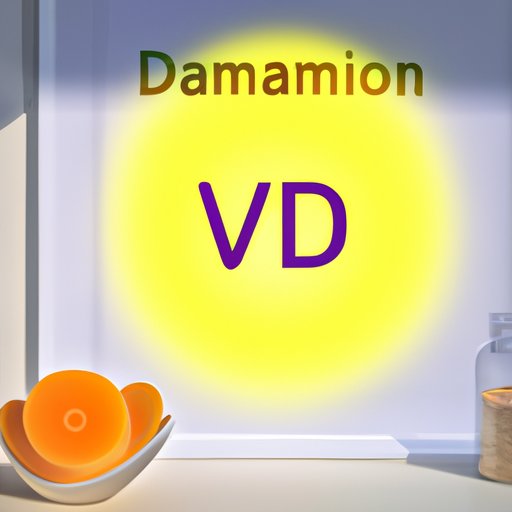
Introduction
Vitamin D is vital for good health, playing a crucial role in bone growth, immune function, and other bodily processes. Many people assume that they can get vitamin D simply by sitting near a window on a bright day, but is this really accurate?
In this article, we’ll explore the science behind vitamin D synthesis and the impact of window glass on this process. We’ll also consider other factors that may affect vitamin D intake and offer guidance on how to maintain a healthy level of this essential nutrient.
The Science Behind UVB Rays and Vitamin D Synthesis
UVB (ultraviolet B) rays are the specific type of sunlight that is responsible for vitamin D synthesis in the body. This happens when a molecule in the skin, 7-dehydrocholesterol (7-DHC), absorbs UVB radiation and converts it into pre-vitamin D3.
The pre-vitamin D3 then undergoes a chemical reaction, converting it into vitamin D3 (cholecalciferol), which enters the bloodstream and is transported to the liver and kidneys for further processing before being used by the body.
However, while UVB rays can penetrate skin, they can be blocked by window panes. This is because the glass used in most windows can absorb or deflect UVB radiation. As a result, sitting near an indoor window doesn’t necessarily provide adequate UVB radiation to synthesize vitamin D.
Types of Glass and UVB Radiation
There are different types of glass that can be used in windows, and each has its own level of UVB radiation absorption or deflection.
Standard window glass, for example, can block up to around 97% of UVB radiation. On the other hand, low-E glass (which has a coating to reduce heat transfer and enhance energy efficiency) can block up to around 95% of UVB, while laminated glass (used in car windshields) can block up to 99% of UVB.
There are also different thicknesses of glass that can affect UVB penetration, as thicker glass can absorb more radiation.
The Effectiveness of Window Glass in Allowing UVB Rays to Pass Through
Studies have been conducted to test the effectiveness of window glass in allowing UVB rays to pass through. One study found that less than 5% of UV radiation was transmitted through standard window glass, while another study estimated that window glass transmits fewer than 1% of UVB rays.
However, it’s worth noting that results from different studies may vary based on the specific conditions tested, such as the type of glass used, the thickness of the glass, and the angle of sunlight exposure.
Overall, while some UVB radiation may still penetrate through certain types of glass, it’s generally not sufficient to support vitamin D synthesis.
Latitude, Seasonality, and Vitamin D Synthesis
The amount of UVB radiation that reaches the earth’s surface is affected by latitude and seasonality. This means that areas closer to the equator will generally receive more UVB radiation year-round, while areas further away will receive less – particularly during the winter months.
This can impact vitamin D synthesis, as people in areas with less sunlight exposure may need to rely more on direct sunlight exposure to synthesize adequate levels of vitamin D.
Furthermore, different types of glass may have a greater impact on vitamin D synthesis in areas with less sunlight exposure, as even small amounts of UVB radiation can make a significant difference.
Other Sources of Vitamin D
For individuals who don’t get enough direct sunlight exposure, there are alternative sources of vitamin D. For example, some foods are naturally rich in vitamin D, such as fatty fish, egg yolks, and mushrooms.
In addition, many foods are fortified with vitamin D, including milk, orange juice, and cereals. Supplements are also available, with vitamin D3 being the most common form.
Indoor vs. Outdoor Lifestyles and Vitamin D
Living an indoor lifestyle, such as working in an office or spending most of the day at home, can lead to lower levels of vitamin D synthesis. On the other hand, spending more time outdoors can increase UVB exposure and vitamin D synthesis.
However, it’s important to take proper sun protection measures when spending time outdoors, such as wearing protective clothing, using sunscreen, and seeking shade during peak hours of sunlight exposure.
The Risks and Benefits of Vitamin D Obtained through Sun Exposure and Supplementation
While vitamin D is essential for good health, it’s important to consider the potential risks and benefits of obtaining it through sun exposure and supplementation.
Sun exposure, especially prolonged exposure without proper sun protection, can increase the risk of skin cancer and premature aging of the skin. Supplementation, on the other hand, can lead to adverse effects if taken in excess.
It’s important to follow safe and effective guidelines for vitamin D intake, such as consulting with a healthcare provider and monitoring blood levels of the nutrient.
Conclusion
Getting vitamin D through a window is generally not an effective way to maintain adequate levels of this essential nutrient. Fortunately, there are other sources of vitamin D – such as food and supplements – that can support good health.
However, it’s also important to consider other factors that may affect vitamin D synthesis, such as latitude, seasonality, glass type, and spending time indoors or outdoors.
By taking a comprehensive approach to vitamin D intake, and following safe and effective guidelines, individuals can support good health and well-being.





